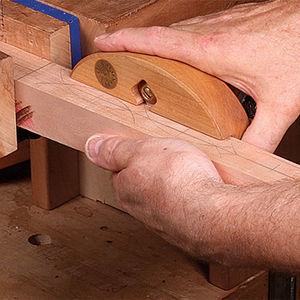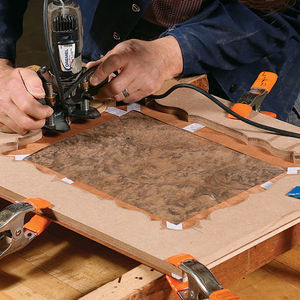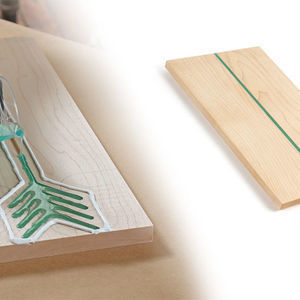Iridescent String Inlay
ZipFlex, a laminated shell material brings sparkle to your work
String inlay has been used for centuries as a decorative detail on fine furniture. In this article, I’ll discuss how to inlay wood using modern manufactured string inlay, which can be used in straight or curved applications. The process is the same, either way.
Traditionally, furniture makers have used woods like ebony and holly to create delicate yet beautiful stringing. There are, however, more exotic materials that have been developed in recent years that can be used for inlay, and these complement modern furniture designs wonderfully, adding more visual interest and complexity to my furniture than traditional wood stringing.
One of the most interesting new materials I’ve been using for string inlay is called ZipFlex, manufactured by Advanced Shell Technology. It’s a flexible version of the straight strips of shell-based material used by luthiers. ZipFlex is available in a variety of colors, including white, gold, and black mother-of-pearl, blue and green abalone, and others in a variety of widths.
ZipFlex is made from a laminated shell material called Abalam, which is sliced into narrow strips and then cut into roughly 1⁄8-in. lengths. These little pieces are held together on a flexible black tapelike material called the matrix (which looks a bit like electrical tape). I’ve found ZipFlex to be extremely useful when doing curved inlay because it is quite easy to bend around even very tight curves. It works equally well in straight sections and the cost is comparable to straight shell strips, though it is much more costly than wood strips.

Installing ZipFlex and similar inlay is much the same as installing traditional inlay: Cut a groove the width of the inlay, glue it in, and trim it flush to the surface. However, before you do any of that, you’ll need to seal the surface surrounding the inlay with several washcoats of shellac (or lacquer). The best glue for this type of inlay is cyanoacrylate, and the shellac protects the wood from being discolored by the glue.
Next is layout, which requires just a few tools. A small adjustable square and a sharp pencil do the job, marking lines parallel to the edge and laying out accurate corners. After layout is complete, it’s time to cut grooves for the inlay. I use a trim router for this. ZipFlex and similar inlay are very narrow, so you’ll need at least one specialty bit. I’ve found that the solid carbide spiral downcut bits from Stewart-MacDonald (stewmac.com) cut well with minimal tearout. The bits have 1⁄8-in.-dia. shanks, so you also need a collet adapter. ZipFlex is typically 0.055 in. thick, and because it should be inlaid slightly proud of the surface, I rout grooves that are a hair shallower than that. To set the bit, I place the router on top of two strips of inlay and lower the bit until it’s just above the benchtop.
For the full article, download the PDF below:
Fine Woodworking Recommended Products

Whiteside 9500 Solid Brass Router Inlay Router Bit Set

Bahco 6-Inch Card Scraper























Log in or create an account to post a comment.
Sign up Log in